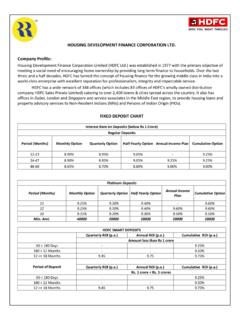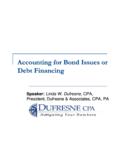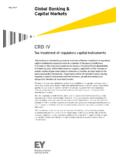Transcription of Q. What is the Debt Market? A. - rrfinance.com
1 Q. What is the debt market ? A. The debt market is the market where fixed income securities of various types and features are issued and traded. debt Markets are therefore, markets for fixed income securities issued by Central and State Governments, Municipal Corporations, Govt. bodies and commercial entities like Financial Institutions, Banks, Public Sector Units, Public Ltd. companies and also structured finance instruments. Q. What are securities? A. Securities are financial instruments that represent a creditor relationship with a corporation or government. Generally they represent agreements to receive a certain amount depending on the terms contained within the agreement. Q. What are fixed income securities? A. Fixed-income securities are investments where the cash flows are according to a predetermined amount of interest, paid on a fixed schedule.
2 Q. Why should one invest in fixed income securities? A. Fixed Income securities offer a predictable stream of payments by way of interest and repayment of principal at the maturity of the instrument. The debt securities are issued by the eligible entities against the moneys borrowed by them from the investors in these instruments. Therefore, most debt securities carry a fixed charge on the assets of the entity and generally enjoy a reasonable degree of safety by way of the security of the fixed and/or movable assets of the company. The investors benefit by investing in fixed income securities as they preserve and increase their invested capital or also ensure the receipt of dependable interest income. The investors can even neutralize the default risk on their investments by investing in Govt. securities, which are normally referred to as risk-free investments due to the sovereign guarantee on these instruments.
3 debt Markets in India and all around the world are dominated by Government securities, which account for between 50 75% of the trading volumes and the market capitalization in all markets. Government securities (G-Secs) account for 70 75% of the outstanding value of issued securities and 90-95% of the trading volumes in the Indian debt Markets. Q. What are the advantages of investing in Government Securities (G-Secs)? A. The Zero Default Risk is the greatest attraction for investments in G-secs so that it enjoys the greatest amount of security possible. The other advantages of investing in G- Secs are: Greater safety and lower volatility as compared to other financial instruments. Variations possible in the structure of instruments like Index linked Bonds, STRIPS Higher leverage available in case of borrowings against G-Secs.
4 No TDS on interest payments Tax exemption for interest earned on G-Secs. up to over and above the limit of under Section 80L Greater diversification opportunities Adequate trading opportunities with continuing volatility expected in interest rates the world over The returns earned on the government securities are normally taken as the benchmark rates of returns and are referred to as the risk free return in financial theory. The Risk Free rate obtained from the G-sec rates are often used to price the other non-govt. securities in the financial markets. Q. Who can issue fixed income securities? A. Fixed income securities can be issued by almost any legal entity like Central and State Govts., Public Bodies, Banks and Institutions, statutory corporations and other corporate bodies. There may be legal and regulatory restrictions on each of these bodies on the type of securities that can be issued by each of them.
5 Q. Who regulates the fixed income markets? A. The issue and trading of fixed income securities by each of these entities are regulated by different bodies in India. For eg: Government securities and issues by Banks, Institutions, Public Corporations are regulated by the RBI. The issue of non-government securities comprising basically issues of Corporate debt is regulated by SEBI. Q. What are the different types of instruments, which are normally traded in this market ? A. The instruments traded can be classified into the following segments based on the characteristics of the identity of the issuer of these securities: Central Government Zero Coupon Bonds Coupon Bearing Bonds Treasury Bills STRIPS Government Securities State Governments Coupon Bearing Bonds Government Agencies / Statutory Bodies Govt. Guaranteed Bonds, Debentures Public Sector Bonds Public Sector Units PSU Bonds Debentures Commercial Paper Corporate Debentures, Bonds, Commercial Paper, Floating Rate Bonds, Zero Coupon Bonds, Inter-Corporate Deposits Banks Certificates of Deposits, Debentures, Bonds Private Sector Bonds Financial Institutions Certificates of Deposits, Bonds The G-secs are referred to as SLR securities in the Indian markets as they are eligible securities for the maintenance of the SLR ratio by the Banks.
6 The other non-Govt securities are called Non-SLR securities. Q. What is the importance of the debt market to the economy? A. The key role of the debt markets in the Indian Economy stems from the following reasons: Efficient mobilization and allocation of resources in the economy Financing the development activities of the Government Transmitting signals for implementation of the monetary policy Facilitating liquidity management in tune with overall short term and long term objectives. Since the Government Securities are issued to meet the short term and long term financial needs of the government, they are not only used as instruments for raising debt , but have emerged as key instruments for internal debt management, monetary management and short term liquidity management. Q. What are the benefits of an efficient debt market to the financial system and the economy?
7 A. 1. Reduction in the borrowing cost of the Government and enable mobilization of resources at a reasonable cost. 2. Provide greater funding avenues to public-sector and private sector projects and reduce the pressure on institutional financing. 3. Enhanced mobilization of resources by unlocking illiquid retail investments like gold 4. Development of heterogeneity of market participants 5. Assist in the development of a reliable yield curve. Q. What are the different types of risks with regard to debt securities? A. The following are the risks associated with debt securities: Default Risk: This can be defined as the risk that an issuer of a bond may be unable to make timely payment of interest or principal on a debt security or to otherwise comply with the provisions of a bond indenture and is also referred to as credit risk.
8 Interest Rate Risk: can be defined as the risk emerging from an adverse change in the interest rate prevalent in the market so as to affect the yield on the existing instruments. A good case would be an upswing in the prevailing interest rate scenario leading to a situation where the investors money is locked at lower rates whereas if he had waited and invested in the changed interest rate scenario, he would have earned more. Reinvestment Rate Risk: can be defined as the probability of a fall in the interest rate resulting in a lack of options to invest the interest received at regular intervals at higher rates at comparable rates in the market . The following are the risks associated with trading in debt securities: Counter Party Risk: is the normal risk associated with any transaction and refers to the failure or inability of the opposite party to the contract to deliver either the promised security or the sale-value at the time of settlement.
9 Price Risk: refers to the possibility of not being able to receive the expected price on any order due to a adverse movement in the prices. Q. Who are the main investors of Govt. Securities in India? A. Traditionally, the Banks have been the largest category of investors in G-secs accounting for more than 60% of the transactions in the Wholesale debt market . The Banks are a prime and captive investor base for G-secs as they are normally required to maintain 25% of their net time and demand liabilities as SLR but it has been observed that the banks normally invest 10% to 15% more than the normal requirement in Government Securities because of the following requirements: Risk Free nature of the Government Securities Greater returns in G-Secs as compared to other investments of comparable nature Q. What is Yield?
10 A. Yield refers to the percentage rate of return paid on a stock in the form of dividends, or the effective rate of interest paid on a bond or note. There are many different kinds of yields depending on the investment scenario and the characteristics of the investment. Yield To Maturity(YTM) is the most popular measure of yield in the debt Markets and is the percentage rate of return paid on a bond, note or other fixed income security if you buy and hold the security till its maturity date. The calculation for YTM is based on the coupon rate, length of time to maturity and market price. It is the Internal Rate of Return on the bond and can be determined by equating the sum of the cash-flows throughout the life of the bond to zero. A critical assumtion underlying the YTM is that the coupon interest paid over the life of the bond is assumed to be reinvested at the same rate.












